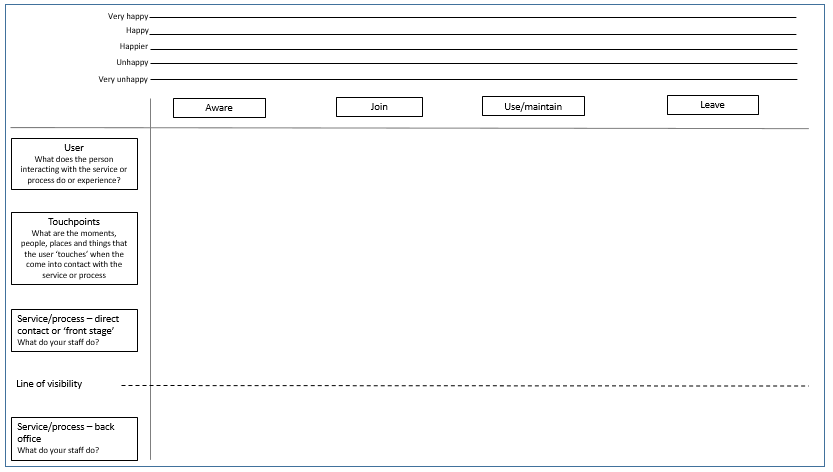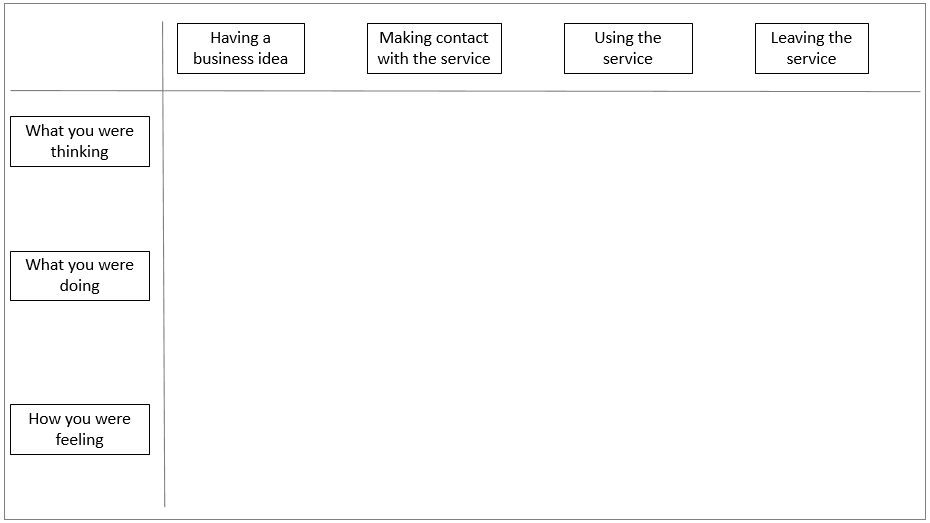Digital
Using service design to improve business support in Scotland
June 8, 2018 by Mark Daniels No Comments | Category Digital Transformation Service, Uncategorized
As part of phase 2 of the Enterprise and Skills review, Scottish Government’s Digital Transformation Service (DTS) were asked to undertake a short, pre-discovery to look at how the current business support services in Scotland were either meeting, or not meeting, user needs.
The business support services we were asked to look at, were those provided by:
- Business Gateway
- Scottish Enterprise
- Highlands and Islands Enterprise
- Skills Development Scotland
- local councils
We decided that the best way of doing this was to take a service design approach – working with actual businesses using these services, and frontline staff who worked with businesses day-to-day, to provide a holistic view of how services were being delivered, consumed, and perceived.
We want to share our thoughts on the parts of this that worked, and parts which could be improved.
What worked
1. Demystifying service design
What we did
One of the first things we did was to run a service blueprinting session with our stakeholders.
This was part of a conscious choice to expose our stakeholders to the world of service design. We wanted to support their understanding of what service design is and how it works. Through this activity, we also wanted to inject service design language and techniques into their thinking.
How it helped
This strategy helped us set expectations at the start about what we were going to do for these business support organisations, as they had the opportunity to get any doubts clarified when they participated in a service blueprinting exercise themselves.
This activity also gave us an insight into what the stakeholders felt the problems with the existing system were – which we could then check with actual users.
2. Draw on a range of specialisms
What we did
To carry out the work, we formed a small multi-disciplinary team.
The core team consisted of a user researcher, content designer, and digital consultant. We also drew on support from a service designer and performance analyst.
How it helped
This mix of skills really complemented each other – each person bringing a different perspective on the work and helping shape the outcomes.
For example, having a content designer as part of the team helped us to think of content as a concept rather than just ‘words on a page’, and as an information set that needs to be findable and easily understood by users.
Additionally, our performance analyst pulled quantitative insights to augment our qualitative research findings and that added another layer of value to our discoveries.
For example, they found one of the most common searches being made across the organisation’s websites was for office locations. We felt this correlated closely with our research findings that showed businesses looked to get in touch with someone they could speak with.
3. Minimising bias
What we did
When it came to recruitment, the organisations had offered to give us access to businesses they were working with.
However, we felt that working with users recruited by the client could potentially introduce bias into our research. Therefore, we decided to use a recruitment agency to find suitable participants instead.
How it helped
Because these businesses were not responding to a request (to participate in our research) from our clients, they did not feel obliged to say ‘the right things’. As a result, we encountered a wide range of user experiences ranging from good, bad, to indifferent.
Importantly, it meant we avoided only seeing businesses who were already working with the organisations and who were therefore already well integrated into the support system.
4. Simplifying our service blueprinting template
What we did
When we ran an initial service blueprinting workshop with stakeholders, we used a more detailed template which described stages of engagement using terms like ‘aware’, ‘join’, ‘use/maintain’, and ‘leave’. This template also looked at things like touch points with the service.
Based on observations from initial sessions that involved clients, our service designer suggested that it would be better to simplify this template when working with users. So we revised our template to make sure it captured what users were thinking, doing and feeling as they were:
- having a business idea
- making contact with the service
- using the service
- leaving the service
We also looked to capture information on the worst part of their experiences, and any opportunities they felt existed for improvements.
How it helped
The simplified service blueprinting template proved to be a really effective stimulus for conversation with users. In particular, it helped us to enable the businesses to talk about their experiences and reflect on how it made them feel.
5. Facilitating empathy with users
What we did
When presenting back our findings, we thought it was important to represent as much user voice and experience as possible. This was particularly important because our stakeholders had been too busy with other commitments to observe our blueprinting sessions.
We put a lot of time into editing the 12 hours of research videos we’d collected. We tied each key insight back to video clips from various users, and found this a really effective way of communicating user needs. We literally had the ‘voice of the users in the room’ when key decisions about services were being made.
How it helped
Showing the organisations what we found, was more powerful than telling them what we found.
And although in some cases we were telling the organisations things they felt they already knew – hearing actual users say it, led them to think again about how they might meet these needs.
What we’d do differently
As with any project there are always things which you feel you could do better. So we thought it might be useful to share some of the things we’d try to do differently next time.
1. Lack of time
What we did
With our project being constrained to just 12 days (albeit non-consecutive days) this placed limitations on the depth of our findings.
To some extent we ran out of time and resource. And although we uncovered a lot of issues in the time we had, we didn’t always gain the same depth of insight we might have wanted.
This meant many of our findings indicated a need for more research.
How we could do things differently
To some extent this was just part of what happened and there wasn’t much we could do to avoid this. Having 12 days to carry out this work was always likely to restrict the depth of our findings – given the task we were asked to carry out.
However, there were some small issues around client expectations and scope which we could have handled differently.
In discoveries (and pre-discoveries) your goals are often subject to change. And sometimes it takes both experienced and inexperienced minds a little while to grasp what’s going on.
As specialists, we could have perhaps made that a bit clearer for our clients upfront. This might have helped them adapt more easily to our changing research strategies. And it could have prevented us having to deal with creeping changes to the project’s scope.
2. Getting access to frontline staff
What we did
The constraints we had in terms of timeframes were exacerbated by the difficulties we experienced in gaining access to frontline staff. We got a sense that certain client organisations were not clear on why we needed to speak to their staff.
How we could do things differently
We could perhaps have explained more fully to the organisations why we needed this access and what we intended to ask about. We had tried to be upfront about this, but in reflection perhaps more detail would have been helpful.
The time it took to get this access, limited what findings we could make from interviews with frontline staff. Consequently, we weren’t able to offer as much detail on the more ‘back stage’ parts of the service blueprint.
3. Running a feedback session
When presenting back our findings, we also felt we didn’t build in enough time to encourage the organisations to reflect on what they had heard and seen.
So in future we’ll aim to run a workshop straight after the presentation, to pull out questions they might have had for users and focus them on generating opportunities for improvements.
What we’ll do next
The organisations are now looking to address our findings through different work streams. We’re continuing to support them in this work and will continue to champion the use of service design techniques as the project progresses.
Tags: business, service design



Leave a comment